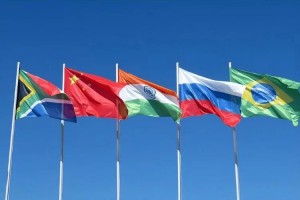With their huge economic size and strong growth potential, the BRICS countries have become an important engine for global economic recovery and growth. This group of emerging market and developing countries not only occupies a significant position in the total economic volume, but also shows the advantages of diversification in terms of resource endowment, industrial structure and market potential.
Economic overview of the 11 BRICS countries
First, Overall economic size
1. Total GDP: As representatives of emerging and developing countries, BRICS countries occupy a significant position in the global economy. According to the latest data (as of the first half of 2024), the combined GDP of the BRICS countries (China, India, Russia, Brazil, South Africa) has reached $12.83 trillion, showing strong growth momentum. Taking into account the GDP contribution of the six new members (Egypt, Ethiopia, Saudi Arabia, Iran, UAE, Argentina), the overall economic size of the BRICS 11 countries will be further expanded. Taking the 2022 data as an example, the total GDP of the 11 BRICS countries reached about 29.2 trillion US dollars, accounting for about 30% of the total global GDP, which has increased in recent years, showing the important position of the BRICS countries in the global economy.
2. Population: The total population of the BRICS 11 countries is also quite large, accounting for nearly half of the world’s total population. Specifically, the total population of the BRICS countries has reached about 3.26 billion, and the new six members have added about 390 million people, making the total population of the BRICS 11 countries to about 3.68 billion, accounting for about 46% of the global population. This large population base provides a rich labor and consumer market for the economic development of BRICS countries.
Second, the proportion of the total economic aggregate in the global economy
In recent years, the economic aggregate of the BRICS 11 countries has continued to increase in proportion to the global economy, and has become a force that cannot be ignored in the global economy. As mentioned earlier, the combined GDP of the BRICS 11 countries will account for about 30% of the total global GDP in 2022, and this proportion is expected to continue to grow in the coming years. Through strengthening economic cooperation and trade exchanges, the BRICS countries have continuously enhanced their status and influence in the global economy.
Economic rankings of the 11 BRICS countries.
China
1.GDP and rank:
• GDP: US $17.66 trillion (2023 data)
• World rank: 2nd
2. Manufacturing: China is the largest manufacturing country in the world, with a complete industrial chain and huge production capacity.
• Exports: Through the expansion of manufacturing and exports to drive economic growth, the value of foreign trade ranks among the top in the world.
• Infrastructure development: Continued infrastructure investment provides strong support for economic growth.
India
1. Total GDP and rank:
• Total GDP: $3.57 trillion (2023 data)
• Global rank: 5th
2. Reasons for rapid economic growth:
• Large domestic market: offers great potential for economic growth. Young workforce: A young and dynamic workforce is an important driver of economic growth.
• Information Technology sector: The rapidly expanding information technology sector is injecting new impetus into economic growth.
3. Challenges and future potential:
• Challenges: Issues such as poverty, inequality and corruption are impeding further economic development.
• Future potential: India’s economy is expected to grow faster by deepening economic reforms, strengthening infrastructure and improving the quality of education.
Russia
1. Gross Domestic Product and rank:
• Gross Domestic Product: $1.92 trillion (2023 data)
• Global rank: The exact rank is subject to change according to the latest data, but remains at the top of the world.
2.Economic Traits:
•Energy exports: Energy is an important pillar of the Russian economy, especially oil and gas exports.
•The military industrial sector: The military industrial sector plays an important role in the Russian economy.
3. Economic impact of sanctions and geopolitical challenges:
• Western sanctions have had an impact on the Russian economy, causing the economy to shrink in dollar terms.
• However, Russia has responded to sanctions pressure by expanding its debt and growing its military-industrial sector.
Brazil
1.GDP volume and rank:
• GDP volume: $2.17 trillion (2023 data)
• Global rank: Subject to change based on latest data.
2. Economic Recovery:
• Agriculture: Agriculture is an important sector of the Brazilian economy, especially the production of soybeans and sugar cane.
• Mining and Industrial: The mining and industrial sector has also made an important contribution to the economic recovery.
3. Inflation and monetary policy adjustments:
• Inflation in Brazil has declined, but inflationary pressures remain a concern.
• Brazil’s central bank continued to cut interest rates to support economic growth.
South Africa
1.GDP and rank:
• GDP: US $377.7 billion (2023 data)
• Ranking may decline after expansion.
2. Economic recovery:
• South Africa’s economic recovery is relatively weak, and investment has fallen sharply.
• High unemployment and declining manufacturing PMI are challenges.
Economic profile of the new member States
1. Saudi Arabia:
• Total GDP: Approximately $1.11 trillion (estimated based on historical data and global trends)
• Oil economy: Saudi Arabia is one of the world’s largest oil exporters, and the oil economy plays a significant role in its GDP.
2. Argentina:
• Total GDP: more than $630 billion (estimated based on historical data and global trends)
• Second largest economy in South America: Argentina is one of the important economies in South America, with a large market size and potential.
3. UAE:
• Total GDP: While the exact figure may vary by year and statistical caliber, the UAE has a significant presence in the global economy due to its developed oil industry and diversified economic structure.
4. Egypt:
• Gross GDP: Egypt is one of the major economies in Africa, with a large labor force and abundant natural resources.
•Economic characteristics: Egypt’s economy is dominated by agriculture, manufacturing and services, and it has actively promoted economic diversification and reform in recent years.
5. Iran:
• Gross Domestic Product: Iran is one of the major economies in the Middle East, with abundant oil and gas resources.
•Economic characteristics: Iran’s economy has been greatly affected by international sanctions, but it is still trying to reduce its dependence on oil by diversifying.
6. Ethiopia:
• GDP: Ethiopia has one of the fastest growing economies in Africa, with an agriculture-based economy transitioning to manufacturing and services.
• Economic characteristics: The Ethiopian government actively promotes infrastructure construction and industrial development to attract foreign investment and promote economic growth.
Post time: Sep-30-2024


